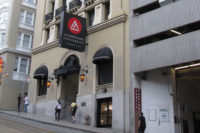Not surprisingly, radio frequency identification (RFID) and that technology’s “little sister” real-time location systems (RTLS) seem to be everywhere doing just about everything. Many times, solutions blend together security and operations at myriad enterprises, organizations and agencies. And, ironically, some of the most cutting edge applications are geographically far flung in areas where it makes business sense to leap-frog at times nonexistent legacy technologies.
Here is a “Radio Flyer Wagon” ride to various world stops showcasing RFID and RTLS applications.
First stop is Hawaii. A long range receiver (in the Ranger line from Farpointe Data) is used to gain admittance to the main gate of the Kolea at Waikoloa Beach Resort on the Big Island. Kolea is a diverse community offering both private residences and two and three bedroom vacation villas. This gated community offers everything desired in a vacation rental. That includes ensuring that only those authorized to be in the community can enter.
Kolea’s organically grown security system includes Napco locksets with integrated card readers and keypads, a Linear gate entry system and Cisco video surveillance.
Integrated Plan for Gated Community Security
Some houses on the property use proximity cards with keypad readers for access from the street and directly from the beach. Those entering the main gate in their car use an RFID approach with a transmitter read by a receiver integrated into the Linear gate entry system via industry standard Wiegand protocol. Instead of using a card, which could activate more than one device or door at a time, the transmitter holder selects exactly the mechanism to be immediately triggered. Available in either a two- or four-button configuration and equipped standard with a weather-resistant potted proximity or contactless smart card module, the transmitter can open two or four different doors from ranges up to 200 feet. Each button outputs transmitter data over separate Wiegand outputs yet the receiver installs just like a proximity reader for easy integration with popular proximity or contactless smart card access control systems.
“Being located here directly on the beach places unique demands on our electronic security infrastructure. Our access control needs have evolved over time, and we’ve been happy with the flexibility and reliability the Ranger series has given us,” reports Trenton Johnson, facility manager for Kolea at Waikoloa Beach Resort. “This dependability means we are no longer continually re-investing in new equipment.”
Next port-of-call is Australia, flying in on Qantas Airlines. There, enhancements to its baggage reconciliation system or BRS from Unisys features tighter security as well as more detailed information about baggage handling requirements for incoming flights, real-time monitoring and alerts of service level agreements as well as a mobile app to provide passengers with live updates on when and where to collect their bags.
It’s a managed service to airlines, airports and authorities responsible for the security of air passenger baggage.
RFID Bag Tag Better than Barcode
Permanent RFID bag tags – sold to passengers as a convenience and a point of loyalty – are processed in a consistent way. As the airline has a record of the baggage loading order, bags can be quickly identified and recovered if passengers fail to board, preventing costly and annoying flight delays as well as a means to enhance security.
A new feature of the BRS is a mobile app to improve the passenger’s experience by providing real-time relevant information about their bags. Travelers receive alerts advising when their bag has been loaded onto the belt. If the BRS is integrated with the airport’s flight information display system, the app can also advise when, and at what carousel, the bag will be available to be collected. Passengers can then decide whether to go directly to the baggage area or spend time in the airport’s shops or restaurants.
Terry Hartmann, Unisys vice president transportation North America, points out how processes implemented to primarily comply with security requirements can be harnessed to improve business operations, too. The RFID tags can be left permanently on a briefcase or suitcase handle and a user can scan the tag along with his or her boarding pass, says Hartmann, who observes that the RFID approach is more efficient and less expensive to handle than barcodes where labels must face a scanner.
Real-Time Location on Industrial Site
Next location is Israel where raw materials supplier Readymix Industries uses an active RFID solution to safeguard employees. The firm installed the RTLS solution (LogiTrack from LogiTag Systems) to first and foremost safeguard its employees working nearby forklifts by alerting the vehicle’s driver and staff in case of safety distance breach.
The solution is installed on the plant’s forklifts, and safeguards hundreds of staff and visitors from life-threatening accidents. The plant is a pilot location with more than 150 staff operating approximately 30 forklifts. The Readymix manufacturing plant, part of Cemex Enterprise, faced common industry challenges when it came to ensuring the safety of its employees, specifically with the forklift operations. Despite tough standards, nearby workers were at risk of being struck or crushed by the vehicle as it weighs several thousand pounds. Forklifts are built differently from normal vehicles, with the front wheels static and back wheels capable of turning at 90-degree angels. Drivers rely on the mirrors to steer while driving back, which in many cases may not be enough, especially in a busy production environment.
Each forklift has an active reader and two antennas, while the staff wears an active RFID tag that also supports a panic button. The hardware is capable of operating under tough environment conditions – water, dust, pressure washing and intense vibrations. In addition, the solution can connect the alarm mechanism with the forklift operator’s breaks in order to stop the vehicle’s movement as soon as a person is in close proximity to the vehicle.
“Readymix is dedicated to the safety and security of all employees, with zero tolerance for human injuries, which is why we turned to RFID,” says Yonatan Scherzer, health and safety manager at Readymix. “As a leader in the construction industry, we invest many resources…In order to avoid accidents, we have training manuals, training, movies and even installed various safety mechanisms including reverse sensors.” Scherzer contends that the RFID application is reliable, quick to implement and “scalable to our growing size and application needs.”
Next Stop: Biotechnology RFID
Then there is Bristol, England, where a unique biotechnology RFID tag is used. Designed by HID Global, the tags meet a critical need in the cryopreservation industry. In partnership with Cryogatt Systems Ltd. of Buxted, East Sussex, Great Britain, HID developed a cutting-edge solution for use at subzero temperatures, increasing storage security while enabling facilities to enhance and streamline logistics.
“Traceability is accurate to satisfy regulatory standards and saves hours of searching,” adds Kirsty Stevenson, manager of cold storage in the Pathology Department of the Bristol Royal Infirmary, a teaching hospital. Other benefits of the RFID solution include improved accuracy, optimized storage space, a precise audit trail, enhanced sample safety and saved time and costs for use at extremely low temperatures in fertility clinics, research laboratories and other storage facilities.
The RFID tags survive the harshness of storage at temperatures of -196° C, -321° F. The patented technology allows for the creation of extremely compact and robust transponders with high memory and security features.
Moving to Nigeria, the West African Examinations Council (WAEC) now registers and authenticates Nigerian students with a mobile ID system that helps combat identity fraud and preserve the value of an education in Nigeria. The technology is on the traditional side of card ID with some twists including handheld mobile readers but could easily one day turn into true RFID.
HID Global launched the system in collaboration with Botosoft Technologies of Lagos, Nigeria. “Implementation of this real-time identification and monitoring system helps bring to life our vision of being a world-class examinations body,” says Charles Eguridu, WAEC’s head of national office Lagos. The use of handheld mobile readers eliminates identity fraud; allows examiners to verify student attendance; and enables them to manage challenges around examination rules violations in real-time. The mobile reader application also saves hundreds of hours of manual data entry and eliminates errors. The time saved allows the examiners to concentrate on the importance of the day as they can be confident that the students are already authenticated for the exam in question.
Back on U.S. soil and centering in Marietta, Ga., PSI Security Service, a contract security guard and patrol company, uniquely uses near field communication (NFC) as well as RFID technologies.
RFID, NFC for Security Officers
Jay Boudrie, the company’s director of security management, likens the evolution of his use of leading edge technologies to the evolution of music from an Edison wax cylinder to downloading albums and streaming audio and video. It serves a business purpose to stay abreast of advances.
Depending on client needs as one factor, PSI Security Service officers can use NFC-enabled smartphones. There must be a touch between the smartphone and an NFC reader. The NFC uses are cloud-based, adds Boudrie. The RFID application uses a wand and a reader with software at both ends with transmission up to 300 feet. When an officer gets done with a tour, he or she then uploads data to the PSI system.
SIDEBAR: Bringing Together Wi-Fi and RFID for Asset Tracking
One solution provides Wi-Fi asset tracking by placing an active RFID tag on every high-value asset, such as carriers, portable storage racks or bins, mobile equipment and vehicles. (An example is MobileView from AeroScout, part of Stanley Black & Decker.) The tags provide asset visibility by sending regular, short bursts of data over the Wi-Fi network transmitting the location, status and condition of the asset. Manufactures use software on workstations or mobile devices to direct workers searching for assets. This automated process can cut average search time to less than one minute.
SIDEBAR 2: Senior Care Goes Real-Time Locating
The technology in this application aims at healthcare, assisted living, nursing home and hospice activities and the challenges these organizations face ranging from wandering patient management, wander alert systems and wander protection with dignity to preventing some of the most commonly cited violations in these operations.
Such an RTLS approach (from Secure Care Products, for example) can come as a suite with modules including:
- • Resident and staff tracking
- • Infection control
- • Temperature monitoring
- • Asset tracking and management














